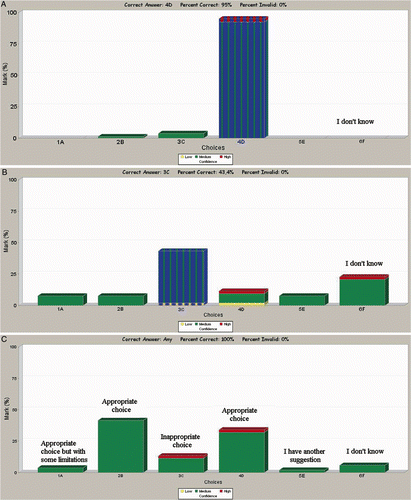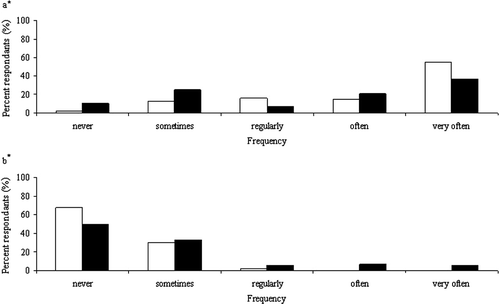Figures & data
Figure 1. Examples of question formats used as teaching strategies during case-based discussions in large groups using the ARS. Compiled responses are presented as a percentage of all students per answer choice. Previously identified correct answer results (blue and green striped bars) appear differently from other results (green bars). Students may optionally indicate their degree of confidence with their response which can be high (red) or low (yellow). A: Question with only one valid answer among 6 possible choices, the last of which is ‘I don’t know’ and with the majority of students having responded correctly. B: Question with only one valid answer among 6 possible choices, the last of which is ‘I don’t know’ and for which there is a greater distribution of students having responded incorrectly or having indicated that they did not know the correct answer. C: Question with several valid answers among 6 possible choices, the last of which is ‘I don’t know’ and for which there is a large distribution in student responses.

Table 1. The perceived usefulness of the clinical pharmacology course for their successful completion of the DVM programme for students having attended case-based discussions in large groups without the ARS (group A) and those with the ARS (group B)
Figure 2. Students’ perceptions of the positive aspects of case-based discussions in large groups without ARS (group A – white) and with ARS (group B – black). Results presented as mean scores for all responses in each group. Question: I liked the case-based discussions in general because: *Group B responses are significantly different from group A responses at p < 0.05.

Figure 3. Students’ perceptions of the negative aspects of case-based discussions in large groups without ARS (group A-white) and with ARS (group B- black). Results presented as mean scores for all responses in each group. Question: I disliked the case-based discussions in general because: *Group B responses are significantly different from group A responses at p < 0.05.

Table 2. Perceived usefulness of case-based discussions for students having attended case-based discussions in large groups without the ARS (group A) and those with the ARS (group B)
Table 3. Students’ short-term (45 days) perceptions of their competence in various skills associated with the teaching objectives of the clinical pharmacology course for those having had case-based discussions without ARS (group A) and with ARS (group B)
Figure 4. Students’ reported frequency of preparing cases alone (a) and preparing cases with colleagues (b) for students having had case-based discussions without ARS (group A- white) and with ARS (group B-black). Results presented as percent respondents for each frequency. *Group B responses significantly different from group A responses at p < 0.05.
